Many visitors to Europe head straight to the big cities. And while the likes of London, Paris, and Rome, are no doubt worthy of your time, consider heading off the beaten path if you’re searching for fascinating history and plenty of charm — without the crowds. Here are seven of our favorite underrated small towns to visit in Europe.
Wengen, Switzerland

Timbered chalets and lavish Belle Époque hotels are among the highlights of this picture-perfect Swiss town. But nothing human-made can compete with the majestic scenery surrounding this quintessential Alpine village in the Lauterbrunnen Valley, known for its 72 waterfalls. Pine-shrouded, snow-capped mountains create a wonderland for photographers even in the summer season. Perhaps best of all, the entire village is free from cars — visitors must take the Wengernalp Railway to reach Wengen, which is perched halfway up the Eiger mountain.
Once safely situated on the mountain, you’ll find a family-friendly basecamp that offers year-round outdoor recreational activities, from skiing, tobogganing, snowshoeing, and sledding to hiking, ziplining, and mountain-biking amongst the peaks. In addition to the traditional chocolates and fondues, Wengen boasts a surprisingly robust fine-dining culture. For an unforgettable meal, take the cable car up to Schilthorn and eat at Piz Gloria, a revolving restaurant that was featured in the 1969 James Bond film On Her Majesty’s Secret Service.
Baile Mòr, Scotland

The name of Baile Mòr — the only village on the tiny Scottish island of Iona — translates to “Big Town” in Scottish Gaelic. That’s quite the misnomer for this tiny hamlet and the isle it calls home, a place with few cars and less than 200 year-round residents. Three miles long and 1.5 miles wide, the craggy expanse more than makes up for its small size with its lush greenery, trim stone cottages, and beautiful white-sand beaches.
Part of the Inner Hebrides archipelago off Scotland’s western coast, Iona hosts around 140,000 visitors each year — mostly pilgrims who arrive via ferry from the nearby island of Mull to visit the stately Iona Abbey, one of the best-preserved medieval structures on the Scottish Isles. The stone abbey was established by St. Columba in 563 CE and is considered the birthplace of Christianity in Scotland. Inside, look for carved stone crosses, illuminated manuscripts, and other notable artwork — Iona has been a center for arts and crafts since the seventh century. Nearby, the ancient St. Orin’s Chapel Cemetery is the final resting place for Macbeth (not just a Shakespearean creation but an actual king) and other medieval monarchs from all over Europe.
Herculaneum, Italy
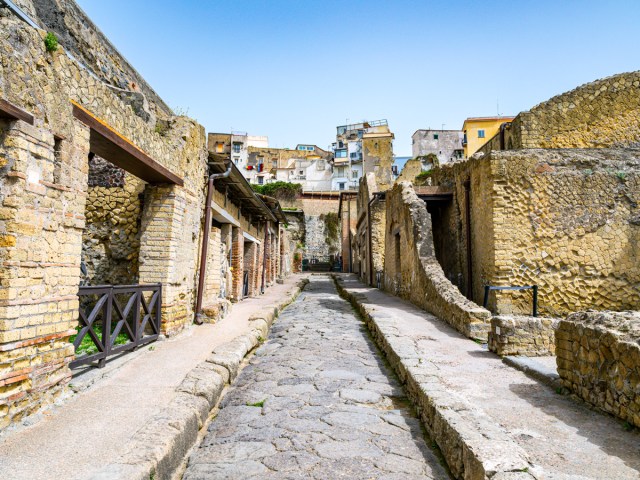
Like its more famous (and more crowded) neighbor Pompeii, the southern Italian town of Herculaneum was destroyed when Mount Vesuvius erupted in 79 CE. Once a seaside resort on the Bay of Naples popular with wealthy Romans, Herculaneum was twice as close to the mountain and immediately covered in more than 50 feet of volcanic rock, mud, and ash.
Following this destructive blanket was a flow of lava, which carbonized organic remains and preserved the interior architecture of the town’s luxurious two-story homes — even furniture, staircases, jewelry, and food remains. While writers such as Goethe and Mark Twain later extolled the wonders of Pompeii — which are no doubt incredible — Herculaneum (although excavated earlier) has remained relatively under the radar.
Visitors to the archaeological park can explore most of the site in two or three hours, getting a glimpse into the private lives of the Roman elites who lived in colorful marble-clad homes with elaborately tiled mosaic floors and beautifully frescoed walls. Notable features include the Villa of the Papyri, with a library containing more than 1,800 carbonized papyrus scrolls, and the boat houses, which hold the skeletal remains of at least 300 unfortunate residents.
Portmeirion, Wales
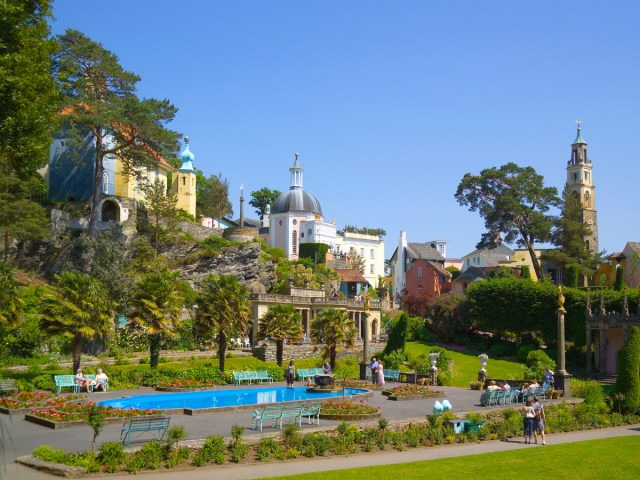
The seaside of North Wales isn’t where you’d expect to find a slice of Italian village life, but Portmeirion appears to offer just that. However, while it may seem to be a functioning village, there is no school or church, nor a town hall or any actual residents. Rather, Portmeirion requires tickets for entry and features shops, restaurants, and rental cottages and hotel rooms geared toward tourists. They’re interspersed among elegant stucco buildings, ornate fountains and statues, and a collection of exotic plantings including palms and a giant sequoia.
Now owned by a charitable trust, Portmeirion was the brainchild of Sir Clough Williams-Ellis, an architect who began work on the project in 1925. The land was the site of a 12th-century castle owned by one of his ancestors. He renamed the tract and modeled his fantasy village after the Italian town of Portofino. Williams-Ellis accessorized the village with ironwork inspired by Bavaria, tiles that wouldn’t look out of place in the Portuguese city of Porto, and other whimsical details. The overall effect is fantastical — and it is credited with influencing the postmodern design movement of the late 20th century.
Ærøskøbing, Denmark
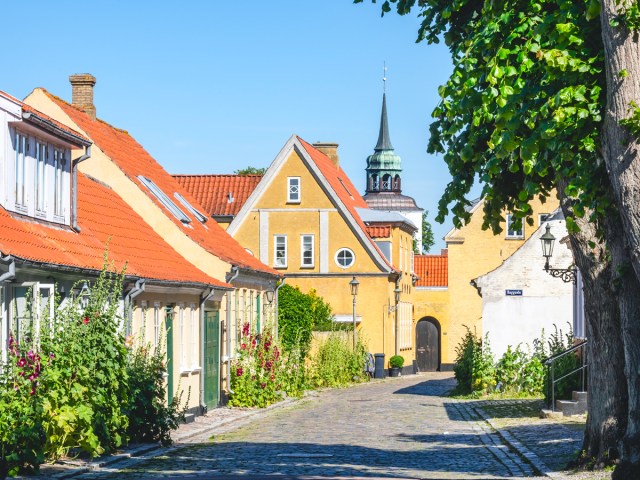
There are plenty of worthwhile reasons to visit the Danish island of Ærø — namely, the gorgeous scenery dotted with blooming hollyhocks, unspoiled beaches along the Baltic Sea, and colorful rows of pastel-painted homes. But couples from all over the world travel to the island for one specific reason: to get hitched. The town of Ærøskøbing, home to only about 1,000 people and one of just three settlements on the island, has become something of a “Vegas of Europe” — famous for fast, bureaucracy-free nuptials that are especially attractive to same-sex and mixed-nationality couples.
Ærø’s location as part of the South Funen Archipelago — about a four-hour journey from Copenhagen — makes it one of the sunniest and warmest parts of Denmark. It’s pleasant enough year-round for all those newlyweds — or any visitors — to enjoy the beaches’ blue waters, moss-covered rocks, and candy-colored bathing huts. And if you think exploring the island feels like stepping back in time, you’re not alone: Ærø was awarded the Europa Nostra Prize for Cultural Heritage in recognition of its 17th-century timbered and terracotta homes, cobblestone lanes, churches dating from the 12th and 13th centuries, and famed Neolithic burial mounds.
Seaford, England
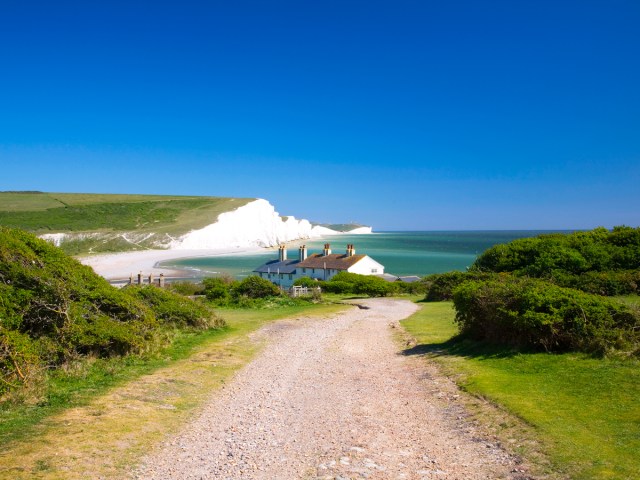
Once a famous port town (or perhaps infamous, given its centuries-long reputation for piracy and shipwreck scavenging), this Sussex stunner is now best known for its resident chalk cliffs, standing in stark relief to the blue-green of the English Channe. Author Charles Dickens was among the thousands of spectators who flocked here in 1850 to watch the Great Explosion of Seaford: an epic gunpowder blast that relieved the cliffs of almost 400,000 tons of chalk in an ultimately failed attempt to counteract local erosion.
These days, the cliffs are famous from their star turn in a series of high-profile movies, from Atonement to Mr. Holmes and Harry Potter and the Goblet of Fire. The section of the cliffs known as the Seven Sisters is particularly arresting, as you’ll see from the Seaford Head Nature Reserve, though you shouldn’t miss the Seven Sister and Friston Forest Circular Walk along the cliffside, either.
Giethoorn, The Netherlands
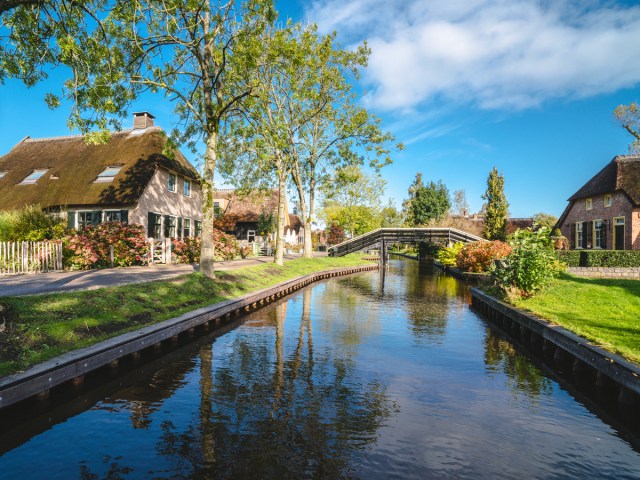
If, for whatever reason, you can’t make it to Italy, Giethoorn, the so-called “Venice of the Netherlands,” is a worthy stand-in. But where Venice looms large with grand canals, plazas, and churches, Giethoorn is comparatively tiny and serene, and leans heavily into its fairy-tale charm. Located about 90 minutes from Amsterdam at the northern end of the province of Overijssel, This dreamy Dutch town of around 2,000 people is blessedly free from automobiles, allowing visitors to step back in time and admire the thatched-roof cottages and flower-filled gardens that border the narrow footpaths and swan-filled canals.
Many of Giethoorn’s historic homes are situated on self-contained peat islands, accessible by charming wooden bridges. For peak serenity, rent a “whisper boat” and arrive on a weekday to avoid crowds. Giethoorn is in close proximity to National Park Weerribben-Wieden, which is well-worth a side trip. The largest fen (peat-forming wetland) in northwest Europe, the park has lakes, canals, and ponds punctuated by peatlands and majestic forests.
More from our network
Daily Passport is part of Inbox Studio, which publishes content that uplifts, informs, and inspires.
















